Some dinosaurs could reach enormous sizes. In fact, the very biggest would tower over any land animal alive today!
Get to know some of the largest dinosaurs to have ever walked the planet.
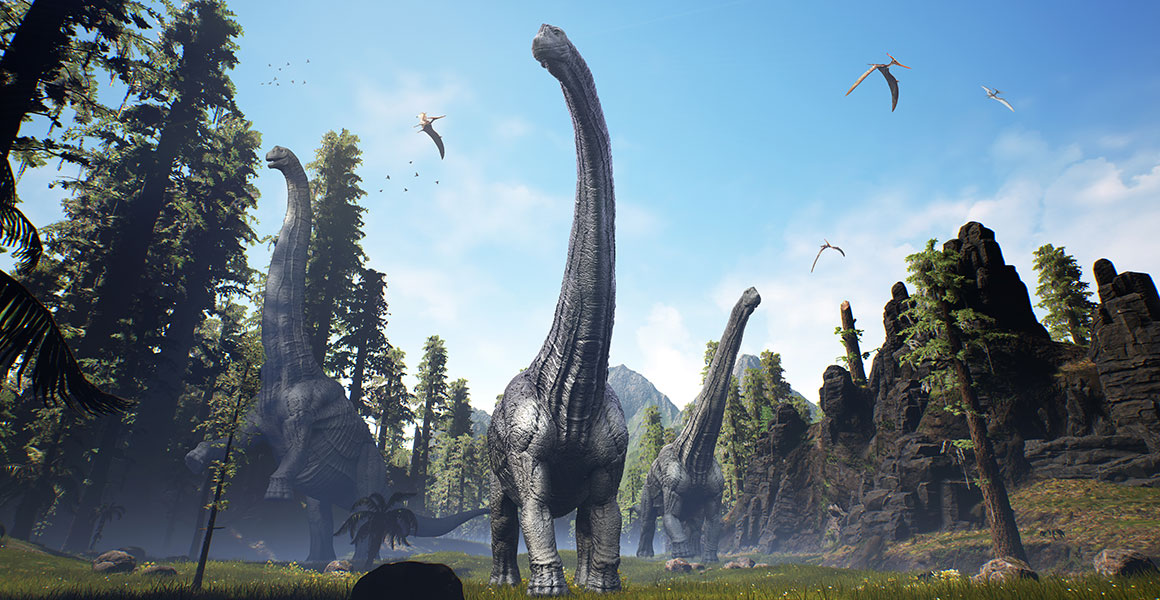
The biggest dinosaurs in the world were titanosaurs. In fact, these prehistoric reptiles are the largest land-dwelling animals that have ever existed. © Herschel Hoffmeyer/ Shutterstock
Some dinosaurs could reach enormous sizes. In fact, the very biggest would tower over any land animal alive today!
Get to know some of the largest dinosaurs to have ever walked the planet.
Dinosaur size estimates often need to be taken with a pinch of salt.
It’s one thing to work out how long a dinosaur was when you have a relatively complete skeleton. It’s a trickier task when you’ve only got a few bones to work with.
“The only way you can really do it is to find a closely related dinosaur that we know the whole skeleton of and assume the proportions are the same,” explains our palaeontologist Dr Susie Maidment. “But just because they’re closely related doesn’t mean the tail or neck were the same length, or they might have been taller – it isn’t straightforward.”
Then there’s mass. How much a dinosaur weighed can be estimated in a couple of ways.
For example, in living quadrupeds if you add together the circumference of the humerus, which is the upper arm bone, and femur, which is the thigh bone, the result is directly proportional to the animal’s mass. In theory, this means that if you had the limb bones of a dinosaur, you could calculate how much it weighed.
But the largest animals we’re certain this method works for are six tonne African elephants. The biggest dinosaurs may have been ten times heavier.
“There might be questions over how valid those extrapolations are,” says Susie. “The error bars are also extremely large. We did this for Sophie the Stegosaurus and we ended up with a body mass of anywhere between 1.5 and six tonnes, which is a very big difference.”
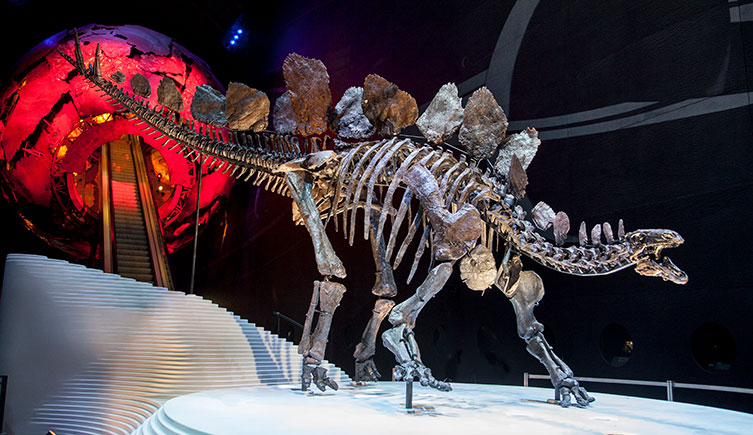
Sophie the Stegosaurus measures just over 5.5 metres long, though these reptiles could reach up to nine metres. This dinosaur is on permanent display in our Earth Hall.
Another approach takes a digital model of the skeleton and shrink wraps it in ‘skin’ to work out the minimum possible body size. The shape is then expanded by 21% to account for the average ‘fleshiness’ of an animal.
“Then you can take the average value of tissue density and apply that to different segments,” explains Susie, “and because it’s computational we can do things like removing a volume that represents the lungs in the body cavity.”
Having volume and density means that the mass for each segment can be worked out and added together to get the total body mass.
“It’s quite a nice method that is well validated in living animals. It seems to work quite well and have a relatively small error bar. But this way does rely on having a really complete skeleton.”
Scientists like to know body mass as it can help them investigate aspects of dinosaurs’ biology, potentially things like home ranges, clutch sizes and metabolism.
“It’s not direct and if you were going to do it on living animals, the relationship between body mass and home range sizes for example is not straightforward,” says Susie, “but mass is a major descriptor that helps us understand how these animals fitted into their environment and the way that they might have been living.”
The largest dinosaurs ever to exist belong to a group known as sauropods. These herbivorous long-necked, long-tailed reptiles include famous faces such as Dippy the Diplodocus and Brontosaurus.
These giant prehistoric animals first appeared in the Late Triassic but reached their largest sizes during the Cretaceous Period.
The biggest dinosaurs of all were titanosaurs. They were one of the last surviving groups of sauropods when the asteroid that caused the non-avian dinosaur extinction collided with Earth 66 million years ago.
Not all titanosaurs were huge – Magyarosaurus was only about five metres long – but many were record-breaking giants. Here are some of the biggest found so far.

A palaeoartist’s impression of how Patagotitan might have looked in life. Image © PaleoEquii via Wikimedia Commons, licensed under CC BY-SA 4.0
Weight: 57 tonnes
Length: 37.5 metres
As well as being a hefty weight, Patagotitan is also potentially the longest dinosaur to have ever lived. This giant is thought to have stood around eight metres tall. One of its leg bones alone was over two metres long – taller than most people!
In fact, Patagotitan would have been more than nine times heavier than an African elephant, which is the largest land animal alive today.
Patagotitan lived around 101 million years ago during the Early Cretaceous.
Fossils of this prehistoric reptile were found in Chubut Province, Argentina. It’s one of the most complete titanosaurs found so far, so there’s more certainty about its size than other dinosaurs that are sometimes claimed be the world’s biggest, such as Puertasaurus and Argentinosaurus.
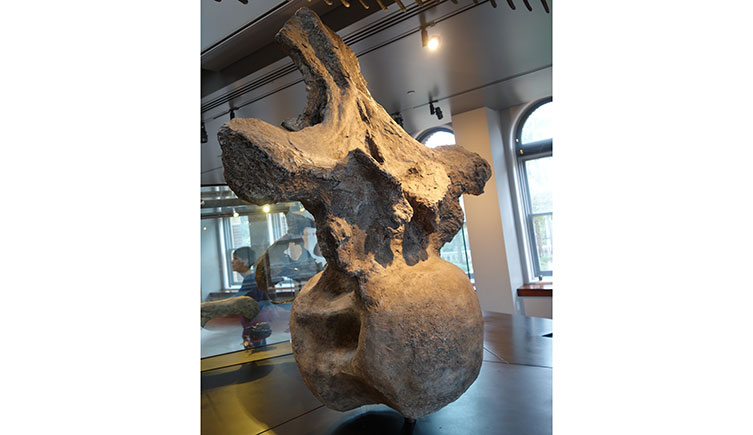
Very little of Argentinosaurus has been found. This is a cast of one of this dinosaur’s giant vertebrae – backbones – on display at the Natural History Museum of Los Angeles. Image © Etemenanki3 via Wikimedia Commons, licensed under CC BY-SA 4.0
Weight: 70 tonnes
Length: 35 metres
The titanosaur Argentinosaurus is another of the largest land animals to have ever lived. But it’s only known from fragmentary remains, which makes calculating its size, and particularly its body mass, tricky.
Fossils of this dinosaur were found in Neuquén Province, Argentina, with the first discovered in 1987. Palaeontologists have found fossils of its leg bones, a few vertebrae and ribs, and part of the sacrum – a collection of fused vertebrae at the base of the spine.
Argentinosaurus lived around 90 million years ago during the Late Cretaceous. Estimates suggest this dinosaur would have been shorter from nose to tail than Patagotitan, but heavier, weighing about the same as twelve elephants.

Puertasaurus is known from very few bones – those we’ve found so far are shown on this diagram – but it’s still thought to be among the biggest dinosaurs discovered so far. Image © Slate Weasel via Wikimedia Commons, licensed under CC0 1.0
Weight: 50 tonnes
Length: 30 metres
Puertasaurus is only known from four vertebrae, but even these fragmentary remains suggest this dinosaur was one of the largest titanosaurs. The dorsal vertebra found is one of the broadest of any known sauropod, suggesting it had a particularly wide rib cage.
Puertasaurus lived around 76-70 million years ago during the Late Cretaceous. Fossils of this animal were found in southwestern Patagonia in Argentina.

Some estimates for Dreadnoughtus suggest this dinosaur weighed as much as an aeroplane. Image © Kenneth Lacovara via Wikimedia Commons, licensed under CC BY-SA 4.0
Weight: 59 tonnes
Length: 26 metres
Dreadnoughtus is yet another large titanosaur from Argentina. It lived at the same time as Puertasaurus.
The extreme mass of this dinosaur is a bit controversial as this animal was likely around the same length as Diplodocus, which only weighed 15 tonnes.
Initial estimates had Dreadnoughtus weighing more than a Boeing 737 aircraft, at over 59 tonnes. Subsequent calculations based on body volume models rather than leg bone circumference have scaled down this animal’s weight down to 22 tonnes. Other estimates place it somewhere between the two.
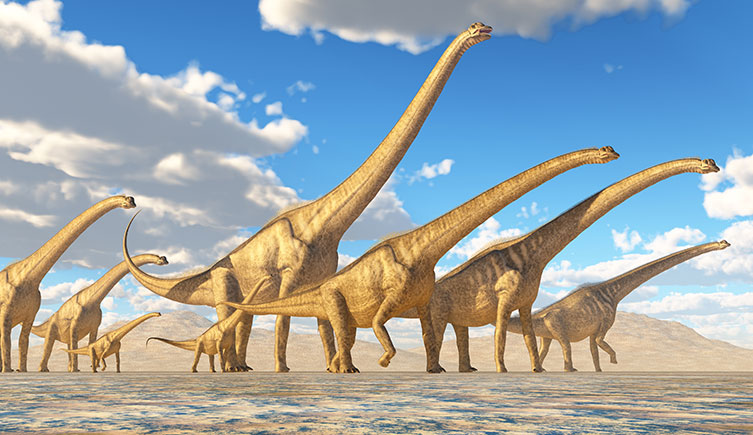
Scientists once thought the Sauroposeidon bones they had found were ancient trees due to the massive size of the fossils. © Catmando/ Shutterstock
Weight: 40-60 tonnes
Length: 27-34 metres
Sauroposeidon lived around 118-110 million years ago in the Early Cretaceous.
When the first Sauroposeidon fossils were found in the USA in 1994, experts initially thought that they might be fossilised trees given their enormous size.
The fossils were eventually realised to be vertebrae. The longest is 1.4 metres, meaning that this sauropod’s neck is estimated to have been up to 12 metres long overall.
While this is very long, it’s marginally shorter than the 15-metre-long neck of Mamenchisaurus sinocanadorum, which may be the longest dinosaur neck found so far.
But size estimates for Sauroposeidon may not be quite right. This dinosaur’s vertebrae have often been compared with those of the brachiosaur Giraffititan, itself once thought to be the largest known dinosaur. However, these dinosaurs are not be as closely related as previously thought. Sauroposeidon is now believed to be more closely related to titanosaurs than brachiosaurs.
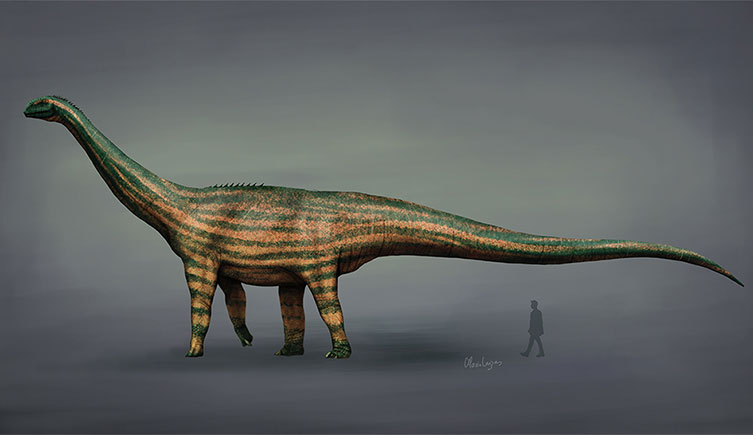
Turiasaurus is the largest dinosaur to have been found in Europe. Image © Mario Lanzas via Wikimedia Commons, licensed under CC BY-SA 4.0
Weight: 51 tonnes
Length: 30-39 metres
Turiasaurus lived around 155-146 million years ago, in the Late Jurassic Period.
Bones of this giant sauropod were found in Spain, making Turiasaurus the largest dinosaur found in Europe so far.
Palaeontologists have found skull fragments of this dinosaur and estimate the head would have been 70 centimetres long. Fossils of Turiasaurus forelimbs, teeth, vertebrae and ribs have also been dug up.
In lists of biggest dinosaurs, plant-eating sauropods claim all the top spots, but large meat-eating dinosaurs lived alongside them in the Mesozoic Era.
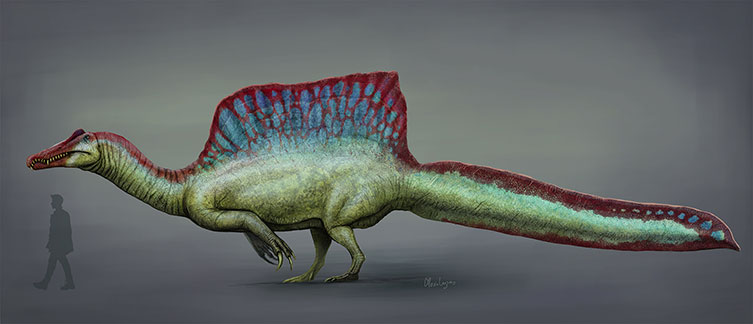
A reconstruction of Spinosaurus based on research that suggested this dinosaur was likely a semi-aquatic animal, spending time hunting in and around water. Image © Mario Lanzas via Wikimedia Commons, licensed under CC BY-SA 4.0
Weight: 7.4 tonnes
Length: 14 metres
Spinosaurus was an enormous theropod dinosaur that lived around 95-70 million years ago in the Late Cretaceous. It’s the longest carnivorous dinosaur currently known, around three times the length of an African elephant and more than 20% heavier.
Spinosaurus is well-known for having a large hump or sail along its back. There are several theories on what this was for, including mating displays, body temperature regulation or even intimidation of other animals.
Spinosaurus may have been an outlier when it comes to dinosaurs, possibly having lived a semi-aquatic life, hunting for fish while fully submerged in water, though this idea is contested by some scientists.

Giganotosaurus may have hunted giant sauropods such as Argentinosaurus. © Herschel Hoffmeyer/ Shutterstock
Weight: 7.2 tonnes
Length: 13 metres
Giganotosaurus was another of the largest carnivorous dinosaurs. Its exact size is difficult to work out however, as we only have fragmentary remains of this predator. Some estimates suggest it was around the same size as another famous Cretaceous carnivore, Tyrannosaurus, which lived a few million years later.
Giganotosaurus has been found in what’s now Argentina. It may have hunted giant sauropods such as Argentinosaurus. Another titanosaur predator and a close relative of Giganotosaurus, Tyrannotitan, is thought to have been just slightly smaller.
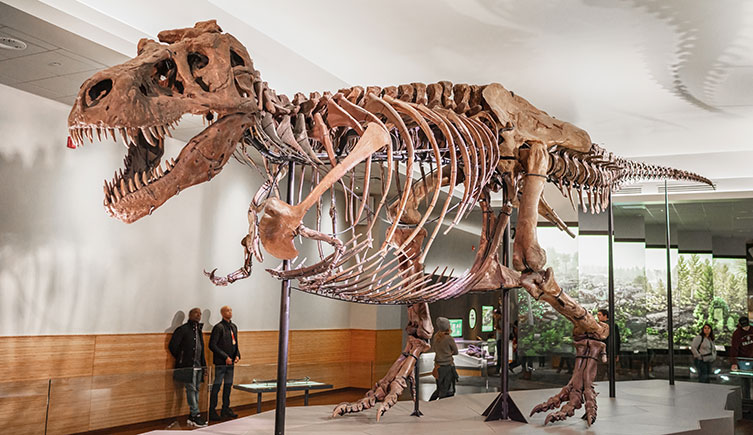
This is Sue, one of the largest and best-preserved Tyrannosaurus rex skeletons ever found. This famous specimen is on display at the Field Museum of Natural History in Chicago. Image © JJxFile via Wikimedia Commons, licensed under CC BY-SA 4.0
Weight: 7 tonnes
Length: 13 metres
Tyrannosaurus is one of the most famous large carnivores of all time. It lived 68-66 million years ago, in the Late Cretaceous.
From nose to tail, Tyrannosaurus reached up to 13 metres. Its skull alone could be 1.5 metres long. But despite this dinosaur’s large body size, it had particularly tiny arms.
Tyrannosaurus was the largest dinosaur in the family Tyrannosauridae. Following close behind in size are other tyrannosaurs such as Tarbosaurus, Albertosaurus and Yutyrannus.
Sauropods were the biggest herbivores, but big dinosaurs did appear in other groups of plant-eaters, particularly ceratopsians and ornithopods such as hadrosaurs.

Shantungosaurus (red) compared to other large ornithopod dinosaurs including Magnapaulia (yellow), Edmontosaurus (brown), Saurolophus (blue), Hypsibema (orange), Charonosaurus (purple) and Iguanodon (green). Image from Slate Weasel via Wikimedia Commons, public domain
Weight: 17 tonnes
Length: 15 metres
Shantungosaurus was a hadrosaur and the largest ornithopod found to date. These dinosaurs lived 78-74 million years ago during the Late Cretaceous, in what is now China. Their skulls reached over 1.6 metres long.
Some scientists suggest Shantungosaurus’ size has been overestimated, and that they may have only reached 13 tonnes – even so, they would still be the world’s largest hadrosaur.
Hadrosaurs are also known as duck-billed dinosaurs due to their flattened snouts. While the front of their mouth was toothless, the back of their jaw was filled with thousands of tiny teeth. Some members of this group had large crests on their heads that may have been used to produce sound.
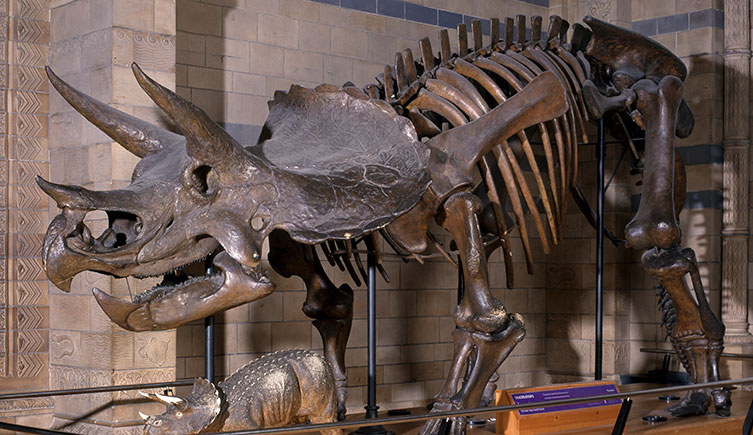
Triceratops was the largest ceratopsian dinosaur. This skeleton model is on display in the Dinosaurs gallery.
Weight: 13 tonnes
Length: 9 metres
Triceratops is among the world’s most famous dinosaurs, known for its parrot-like beak, three facial horns and large frill at the base of its skull. This dinosaur lived around 68-66 million yeas ago, in the Late Cretaceous.
It was the largest ceratopsian dinosaur, about twice as long and heavy as an African elephant.
Large frills are seen in all ceratopsians. In Pentaceratops the skull, including the frill, could be over two metres long. Some scientists suggest that in life, ceratopsian frills may have been colourful and used to attract mates.
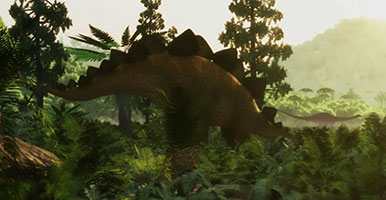
Find out what Museum scientists are revealing about how dinosaurs looked, lived and behaved.
Don't miss a thing
Receive email updates about our news, science, exhibitions, events, products, services and fundraising activities. We may occasionally include third-party content from our corporate partners and other museums. We will not share your personal details with these third parties. You must be over the age of 13. Privacy notice.
Follow us on social media